Why Understanding Your Birth Placement Chart Opens Doors to Self-Findy
A birth placement chart is like a photograph of the sky at your exact moment of birth, capturing the positions of all celestial bodies and serving as your unique cosmic DNA profile. This astrological map reveals insights into your personality traits, natural strengths, potential challenges, and life direction.
Key Components of a Birth Placement Chart:
- Planets – What’s happening (your inner drives and energies)
- Signs – How it’s happening (the style and approach)
- Houses – Where it’s happening (life areas affected)
- Aspects – How planets interact with each other
- Rising Sign – Your outer presentation (changes every 2 hours)
- Sun & Moon Signs – Your core identity and emotional needs
Your birth placement chart goes far beyond your basic Sun sign horoscope. While most people know only their Sun sign, astrology features multiple factors working together. The rising sign changes every two hours, making your exact birth time crucial for accuracy. The Moon changes signs approximately every 2.5 days, so precise timing matters for your complete astrological picture.
Important Note: Birth placement charts are for entertainment and self-reflection purposes. They’re tools for personal insight rather than definitive predictions about your future.
I’m Oracle, and I’ve spent years helping people decode the mysteries hidden within their birth placement charts and numerological patterns. My expertise in birth placement chart interpretation has guided countless individuals toward deeper self-understanding and personal growth.
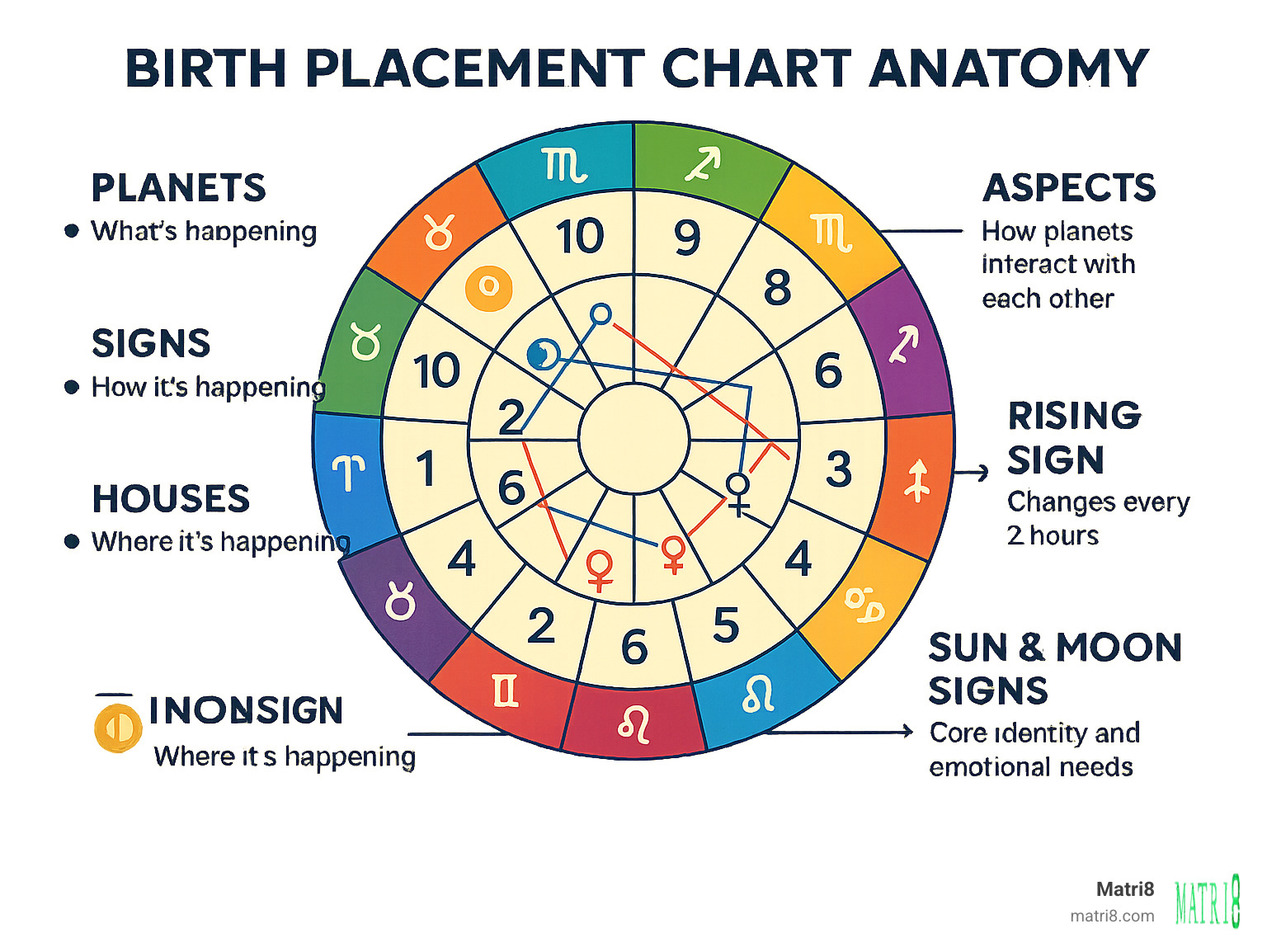
What Is a Birth Placement Chart?
Imagine having a cosmic snapshot of the exact moment you took your first breath. That’s exactly what a birth placement chart is – your personal astronomical blueprint that captures where every planet was positioned when you entered this world.
Also called a natal chart, your birth placement chart is like cosmic DNA that never changes. It’s based on three crucial pieces of information: your birth date, exact time, and birthplace. This creates a 360-degree wheel showing the zodiac signs and planetary positions at your moment of birth.
The most important trio in your chart – what we call the Big Three – forms the foundation of who you are. Your Sun sign represents your core identity and life force. Your Moon sign reveals your emotional world and deepest needs. Your Rising sign (also called the Ascendant) shows how you present yourself to the world and how others first perceive you.
Your Ascendant is particularly fascinating because it changes every two hours. This means someone born just a few hours after you in the same city could have a completely different rising sign, dramatically altering their chart’s interpretation.
Birth Placement Chart vs. Birth Plan: Clearing Confusion
Here’s where things get confusing for newcomers! People often mix up birth placement charts with birth plans, but they’re from completely different worlds.
A birth placement chart belongs to astrology and maps where planets were positioned in the zodiac when you were born. A birth plan is a medical document that expectant parents create to outline their preferences for labor and delivery.
Why Your Birth Placement Chart Matters
Your birth placement chart opens doors to self-understanding in ways that go far beyond your basic Sun sign. It’s like having a detailed personality manual written specifically for you.
Personality insights emerge when you see how different planetary energies blend together. Someone with Mercury in Aries might be a quick, direct communicator, while Venus in Cancer suggests they show love through nurturing and creating cozy spaces.
Understanding your strengths and challenges becomes clearer when you see which planets occupy the angular houses – the 1st, 4th, 7th, and 10th houses. These are the power positions in your chart.
Life direction often reveals itself through patterns in your chart. Jupiter’s placement typically shows where you’ll find growth and good fortune, while Saturn indicates areas where you’ll need to work harder but can build lasting success.
Your birth placement chart doesn’t predict your future or limit your choices. Instead, it illuminates your natural tendencies and potential, helping you make more informed decisions about your path forward.
Decoding the Components: Planets, Signs, Houses & Aspects
Think of your birth placement chart as a complex symphony where every instrument plays a specific role. Planets are like the actors in your personal cosmic drama – they represent what’s happening in your life. Signs are the costumes these actors wear, showing us how they express themselves. Houses are the stages where all this action takes place, revealing which areas of your life get the spotlight. Finally, aspects are the conversations between actors, showing how different parts of your personality interact with each other.
For a deeper dive into how each zodiac sign influences these cosmic players, check out our comprehensive guide on Astrology Zodiac Signs Meanings.
Tropical astrology starts from the spring equinox and works beautifully for psychological interpretation, while Sidereal astrology follows actual star positions and is preferred in Vedic traditions.
| Zodiac System | Starting Point | Best For |
|---|---|---|
| Tropical | Spring Equinox (Fixed) | Western astrology, psychological interpretation |
| Sidereal | Actual star positions | Vedic astrology, astronomical accuracy |
Planetary Players & Their Symbolism
Each planet in your birth placement chart tells a different part of your story.
The Sun represents your core identity – the “you” at the center of everything. It’s your vital spark and creative force.
The Moon governs your emotional world and instinctive reactions. While your Sun shows who you are, your Moon reveals what you need to feel secure and nurtured.
Mercury is your mental messenger, ruling how you think, communicate, and learn.
Venus shapes your approach to love, beauty, and what you value most. This planet reveals how you express affection and what brings you pleasure.
Mars is your inner warrior, representing your drive and ambition. It shows whether you’re likely to charge ahead boldly or take a strategic approach.
Jupiter acts as your personal growth coach, indicating where you find meaning and opportunities for expansion.
Saturn serves as your cosmic teacher, highlighting areas where you’ll face challenges but ultimately develop real expertise.
Uranus represents your need for freedom and your unique, rebellious streak. This planet shows where you’re likely to break from tradition.
Neptune governs your dreams, spirituality, and imagination. It reveals your artistic potential and intuitive gifts.
Pluto deals with power, change, and deep psychological processes that reshape your life.
House System Showdown & Chart Styles
The twelve astrological houses divide your chart into different life areas, but astrologers calculate these divisions using various methods. Placidus remains the most popular system worldwide, creating unequal house sizes that many find more nuanced for personality analysis.
Whole Sign houses offer beautiful simplicity – each zodiac sign equals one complete house. This ancient method has gained renewed popularity because it’s straightforward and historically authentic.
Koch houses work similarly to Placidus and remain popular in America, while Equal houses divide everything into perfect 30-degree segments.
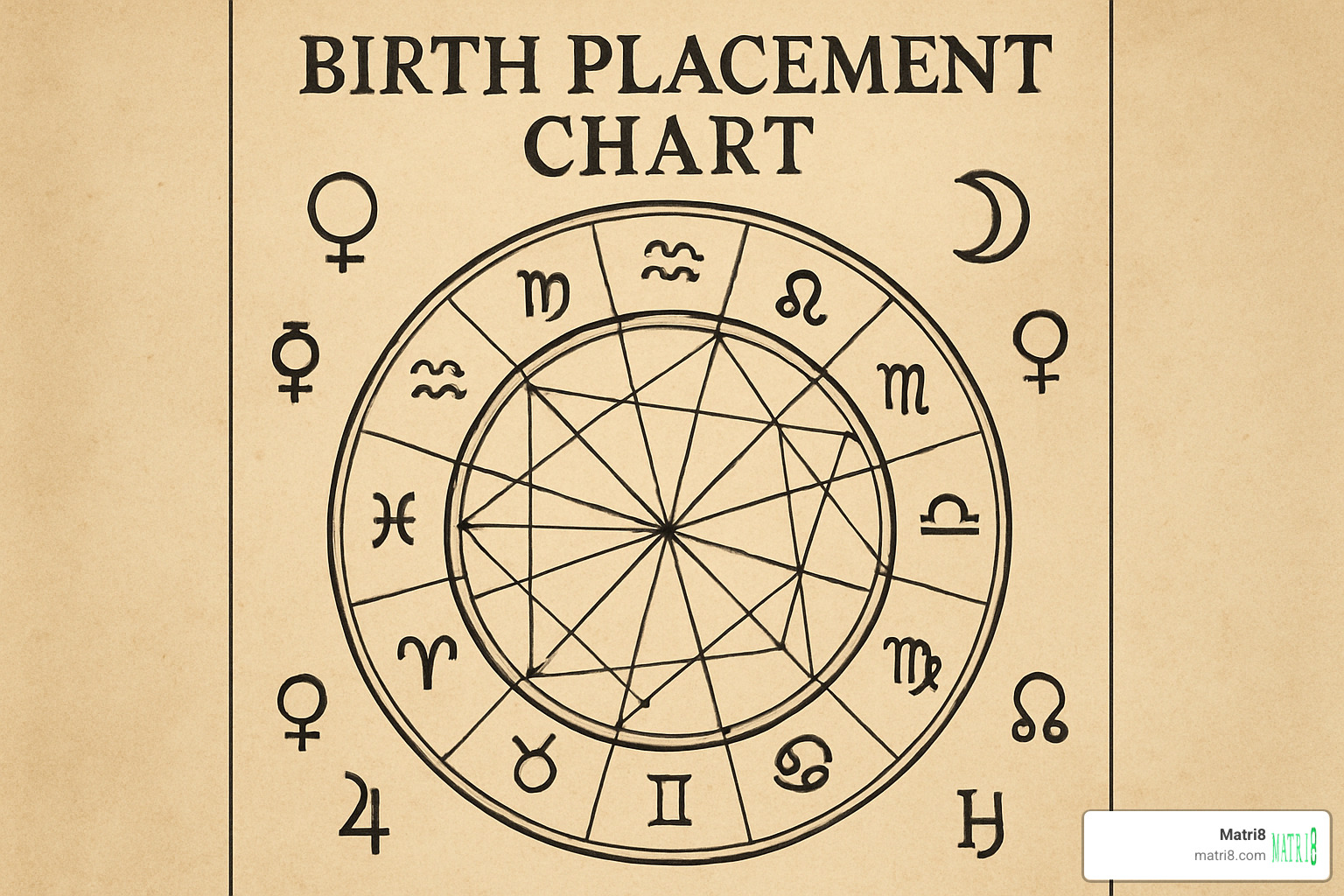
Aspects: Cosmic Conversations
Aspects reveal how different planetary energies interact and influence each other.
Conjunctions happen when planets sit very close together, creating intense, focused energy where planetary influences blend completely.
Trines form when planets are about 120 degrees apart, creating harmony and natural flow. These aspects often indicate talents that come easily to you.
Squares create dynamic tension at 90-degree angles. While squares can feel challenging, they’re actually growth engines in your chart.
Oppositions occur when planets face each other across your chart at 180 degrees, highlighting areas where you need to find balance.
Sextiles offer gentle support and opportunities at 60-degree angles.
The orb – or allowable degree range – determines how strongly you’ll feel each aspect. Tight orbs of 1-3 degrees create powerful influences, while wider orbs of 8-10 degrees offer subtler background themes.
Creating a Precise Birth Placement Chart
Getting an accurate birth placement chart requires three crucial pieces of information: your exact birth date, the precise time you were born, and your birthplace coordinates.
Your rising sign shifts approximately every two hours, which means being off by even thirty minutes could change your entire chart’s foundation. The Moon changes signs roughly every 2.5 days, so on certain days, your Moon could be in completely different signs depending on birth time!
Your birth time is the golden key. If you’re unsure about the exact moment you arrived, your birth certificate is your best friend. Most official documents record time down to the minute. No birth certificate handy? Try contacting the hospital where you were born.
Location coordinates determine everything else. Modern chart calculators use databases containing over 250,000 places worldwide. The precise latitude and longitude affect your house positions and rising sign calculations.
Today’s astrology software uses actual planetary data from NASA calculations, giving you astronomical precision.
Ready to dive deeper into chart creation? Check out our comprehensive Free Astrology Tools for accurate calculations.
Data Accuracy & Rectification Tips
Start with official documents. Your birth certificate remains the gold standard for exact birth time and location.
When records fall short, hospital records become your next best option. Many hospitals maintain detailed birth logs even decades later.
Family memories can help too, though they’re less reliable than official sources. Even approximate timing like “just after midnight” can narrow things down.
What if your birth time remains a mystery? Experienced astrologers use rectification, working backward from major life events to estimate your rising sign and house positions.
Time zones can get tricky, especially for births before 1966 when daylight saving rules weren’t standardized. For detailed guidance on these complexities, the resource Historical Time Zone Issues offers valuable insights.
Popular Calculation Methods
Different astrological traditions approach birth placement chart calculations in their own unique ways.
The Tropical versus Sidereal debate represents astrology’s biggest philosophical split. Western astrology typically uses the Tropical zodiac, which stays fixed relative to Earth’s seasons. Vedic astrology prefers the Sidereal zodiac, which adjusts for the actual positions of constellations.
House system preferences vary among astrologers worldwide. Placidus dominance in modern Western astrology comes from its mathematical precision, though many practitioners swear by Whole Sign houses for their simplicity.
For Sidereal calculations, you’ll encounter different ayanamsa options. The Lahiri ayanamsa remains most popular in Vedic astrology.
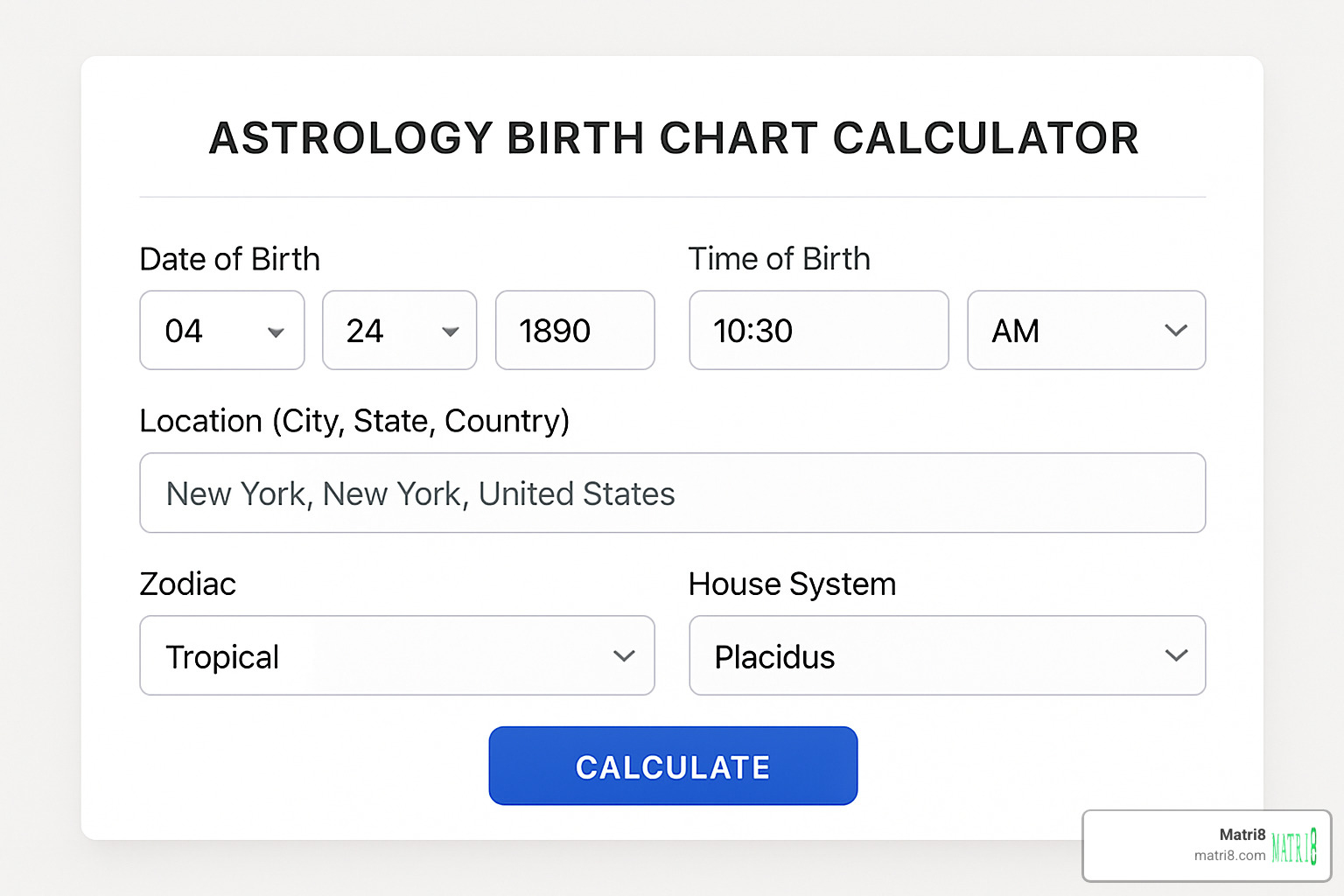
The beauty of modern chart calculation lies in having options. You can experiment with different systems to see which interpretation style speaks to your soul.
Interpreting Your Birth Placement Chart & Going Beyond
Now comes the exciting part – reading your birth placement chart like a cosmic story rather than a collection of random facts. The secret to chart interpretation lies in seeing the big picture and looking for patterns that weave throughout your entire chart.
Chart Synthesis is where the magic happens. Start by noticing which elements dominate your chart. Heavy fire emphasis suggests passion and action, while earth dominance indicates practicality. Water-heavy charts often show deep emotional sensitivity, and air dominance suggests mental, communicative nature.
Stelliums create powerful patterns when three or more planets cluster together in the same sign or house, forming an energy powerhouse that often becomes a major life theme.
Angular planets in your 1st, 4th, 7th, or 10th houses pack extra punch because they sit at the chart’s most dynamic points.
Challenging aspects like squares and oppositions aren’t cosmic punishments – they’re growth opportunities. Meanwhile, easy trines indicate natural talents that often need conscious development.
For detailed guidance on weaving all these elements together, check out our comprehensive Zodiac Birth Chart Interpretation resource.
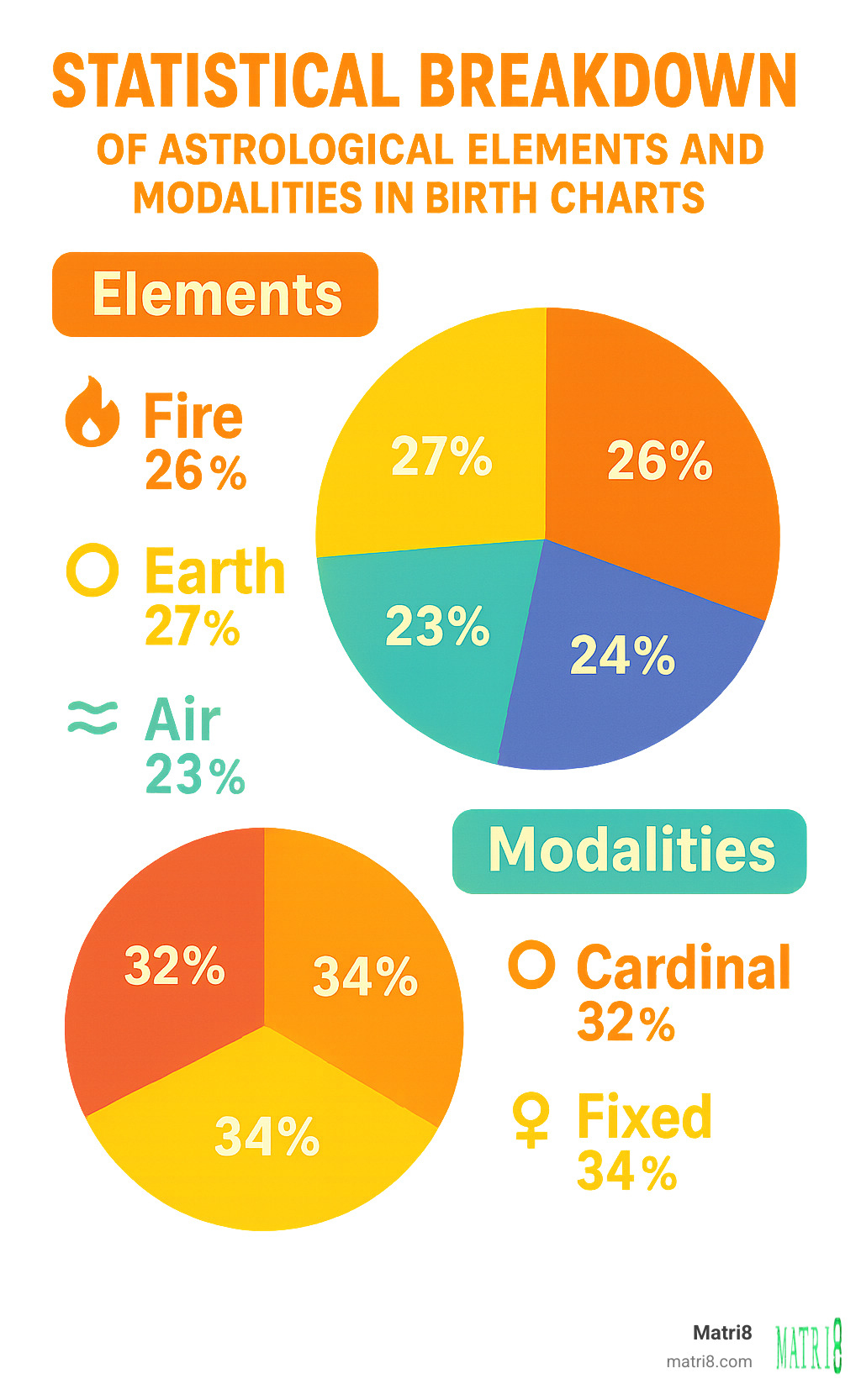
Reading Your Big Three in the Birth Placement Chart
Your Big Three – Sun, Moon, and Rising signs – form the foundation of who you are.
Your Sun sign represents your core self – the essence of who you are when you strip away all the layers. The house where your Sun sits shows where you’re meant to shine brightest.
Your Moon sign governs your emotional world, instincts, and what you need to feel safe. While your Sun shows what motivates you consciously, your Moon reveals subconscious patterns.
Your Rising sign acts like a cosmic filter, coloring how your entire chart expresses itself. It’s your social mask and first impression.
The real magic happens when these three blend together. A Leo Sun with Scorpio Moon and Virgo Rising expresses Leo creativity through intense themes while presenting with practical Virgo energy.
Advanced Tools & Next Steps
Once you’ve mastered your basic birth placement chart, advanced techniques await.
Transit charts show where planets are now compared to your birth positions, helping you understand timing and current themes.
Progression charts reveal your psychological evolution over time, showing how you’re growing and developing new facets.
Synastry compares two people’s charts to understand relationship dynamics, revealing areas of harmony and potential friction.
Solar return charts offer annual forecasts by casting a new chart for each birthday, highlighting major yearly themes.
For comprehensive birth chart analysis that goes beyond the basics, visit our Astrology Birth Chart section.
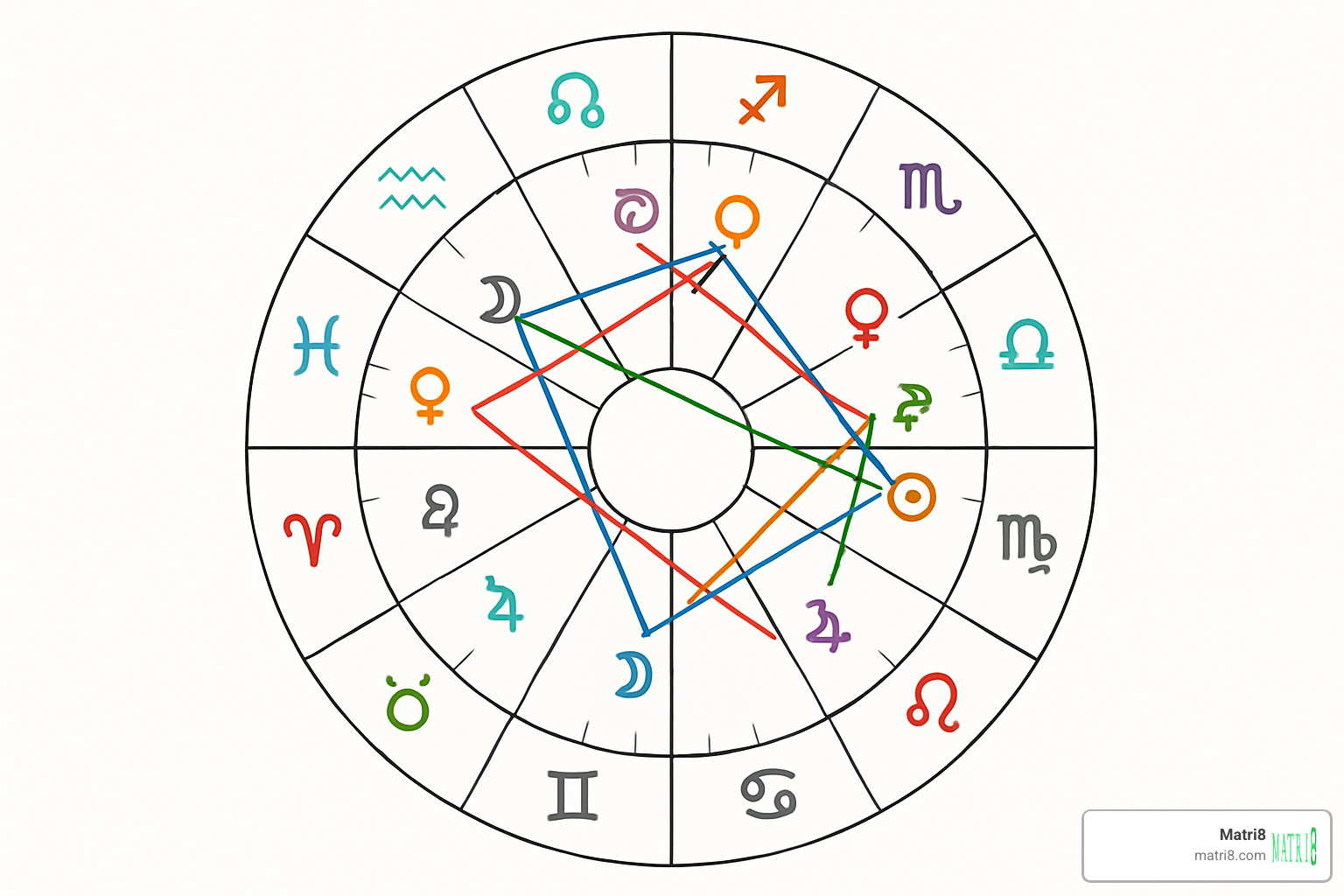
Birth Placement Chart FAQs & Misconceptions
“I don’t know my exact birth time – is my chart useless?” Absolutely not! While you can’t determine your rising sign without precise timing, you can still explore all your planetary sign positions and aspects between them.
“Does my chart determine my fate?” Your chart shows potentials and tendencies – not fixed destiny. Think of it like a weather forecast: it tells you conditions to expect, but you decide how to respond.
“Can astrology predict specific events?” Astrology excels at indicating timing for general themes and energy shifts, but can’t predict specific events with certainty.
“Is there one ‘correct’ type of astrology?” Both Western and Vedic astrology have value within their frameworks. Choose the system that resonates with your goals.
Astrology works best for entertainment and self-reflection rather than as a substitute for professional advice. Your birth placement chart is a tool for understanding yourself better, not a crystal ball.
Conclusion
Your birth placement chart is more than just an astrological curiosity – it’s a deeply personal roadmap to understanding who you are at your core. Think of it as your cosmic fingerprint, unique to you and packed with insights that can guide your journey of self-findy.
From the fiery energy of Mars to the dreamy influence of Neptune, each planetary placement tells part of your story. The houses show where these energies play out, while aspects reveal how different parts of your personality work together or create growth-promoting tension.
What makes your birth placement chart truly special is how all these pieces weave together. Your Sun might be in practical Virgo, but if your Moon is in adventurous Sagittarius and your Rising is in passionate Scorpio, you’re far more complex than any single sign could capture.
At Matri8, we’ve seen how powerful it can be when people find their full cosmic blueprint. Our approach goes beyond traditional astrology by weaving together the wisdom of numbers, stars, and ancient traditions. When you combine your birth placement chart with numerology insights and Chinese zodiac wisdom, you get a complete view of your potential.
The real magic happens when you apply these insights to daily life. Maybe your Venus in the 10th house explains why relationships and career feel intertwined. Or understanding your Saturn placement helps you see why certain challenges keep appearing – and how to work with them.
Your chart isn’t about limiting you or predicting a fixed future. It’s about understanding your natural rhythms, recognizing your gifts, and knowing where you might need extra patience with yourself.
Ready to dive deeper into your cosmic story? Open up the magic of numbers & stars and see how numerology can add another layer to your astrological insights. Your birth placement chart is just the beginning of a lifelong journey of understanding yourself more fully.
The stars were arranged in a unique pattern the moment you arrived on Earth. That cosmic snapshot holds keys to questions you might not even know you’re asking yet. Take the first step today – calculate your chart and start open uping the mysteries of your own amazing, complex, wonderfully human self.